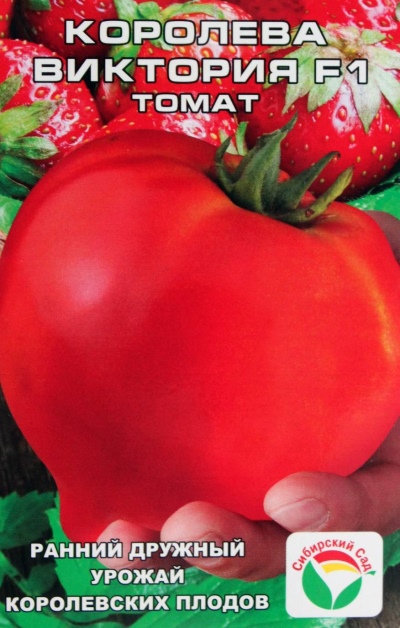
- Category: hybrid
- Growth type: determinant
- Appointment: universal
- Ripening period: early
- Ripening time, days: 83-95
- Growing conditions: for open ground, for closed ground
- Marketability: Yes
- Transportability: Yes
- Bush size: undersized
- Bush height, cm: up to 100
The variety Koroleva Victoria fell in love with Russian gardeners not only because of its high decorative qualities. With proper care of the plantation, you can get a rich harvest that lives up to the royal name. The culture is unpretentious in cultivation and is suitable for inexperienced gardeners.
Description of the variety
The hybrid can be grown both indoors and outdoors. When choosing any of the options, the bushes will feel comfortable. The fruits have a universal purpose. Growth type is determinant. Low-growing bushes grow up to a maximum of one meter. They are semi-sprawling and powerful. Shoots are straight, not curly.
One of the main characteristics of the variety is its dense foliage. The leaves themselves are medium in size, with a standard dark green color. Despite the low growth of the bushes, it is advisable to tie them up, since large fruits pull the branches to the ground. The type of inflorescence is simple. The first fruit cluster is laid after the fifth leaf, and the rest alternate after 1-2 leaves.
The main qualities of the fruit
Ripe tomatoes acquire a rich red color. In mass, they gain 190-300 grams. The sizes are marked as large. They resemble strawberries in shape (rounded tomatoes with a neat spout at the top). The pulp is fleshy and firm. The color of the pulp is the same as that of the peel. The keeping quality of the fruit is good. The peel perfectly retains the shape of tomatoes during long-term storage and transportation, protecting the crop from cracking.
Note: The increased meatiness of tomatoes will be beneficial when preparing snacks, sandwiches and salads.
Taste characteristics
The taste of ripe tomatoes is excellent and harmonious. The fruit is a wonderful combination of sweetness and pleasant sourness.
Ripening and fruiting
Queen Victoria is an early ripening variety. From the first shoots to the moment of harvesting, it takes from 83 to 95 days. The fruiting type is long-term. Ripe tomatoes are harvested from July to August. The exact timing of harvesting vegetables depends on the climate in the growing region. The bushes are able to bear fruit before the arrival of autumn frosts.
Yield
The yield of the hybrid is high. From the m2 of the plantation, 15 to 17 kilograms of vegetables are harvested. The high marketability and transportability are separately noted.
The timing of planting seedlings and planting in the ground
Sowing seeds for seedlings is carried out in March or April. Young seedlings are transplanted into the ground in June or May. The seed must be prepared in advance. Treatment is carried out using disinfectants and growth stimulants. In order not to waste time on these procedures, you can purchase ready-made seeds that have already passed all stages of processing.
To grow seedlings, you need to create the following conditions:
optimal humidity level - 80%;
indoor temperature - from +25 to +27 degrees Celsius, this mode is maintained until shoots appear, then the temperature is lowered to + 19 ... 20 degrees;
the soil is moistened 2 times a week;
containers with seedlings need to be aired for 15 minutes 1-2 times a week;
seedlings are hardened 10 days before transplanting into the ground at a temperature of + 15 ... 16 degrees.

Growing tomato seedlings is an extremely important process, because it largely depends on whether the gardener can harvest at all. All aspects must be taken into account, from seedbed preparation to planting in the ground.
Landing scheme
No more than three bushes are placed on one square meter of the site. This pattern is due to large brushes and a thick green mass. If plants are planted too close to each other, yields can be reduced.

Growing and care
Hybrid vegetable culture Queen Victoria does not make high demands on care. It is enough just to irrigate the land in time and feed the bushes. Any soil is suitable for growing, but despite its fertility, you cannot do without additional fertilizing. Tomatoes must be fertilized during the ovary and fruit filling. Complex formulations are widely used. And you can also use natural humus.
The variety reacts actively to watering. For juicy and tasty tomatoes, you need to regularly moisturize the plantation. One plant consumes from 1 to 3 liters of water. 2-3 waterings are carried out per week. When cultivating a variety in greenhouses, the room must be ventilated every day.
Despite the fact that the trunk of the bushes is strong, the plants need to be tied up. Large fruit brushes are fixed separately. Posts or pegs are used as supports. Tomatoes are tied to trellis structures.
The land plot must be periodically loosened so that a dry and rough crust does not form on the surface. Weeds are also regularly removed.




A plant needs different micronutrients at each stage of growth. All fertilizers can be divided into two groups: mineral and organic. Folk remedies are often used: iodine, yeast, bird droppings, eggshells.
It is important to observe the rate and period of feeding. This also applies to folk remedies and organic fertilizers.
Disease and pest resistance
The Queen Victoria variety is highly resistant to the following diseases:
top rot of fruit;
fungal infections;
alternaria;
common bacterial diseases;
tobacco mosaic virus;
And also the bushes are not afraid of high temperatures and are resistant to stress. Unfavorable weather conditions will not affect the yield. To protect the plantation from late blight and other diseases, it is necessary to treat the soil with copper solutions.



























































































